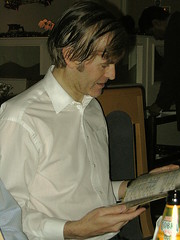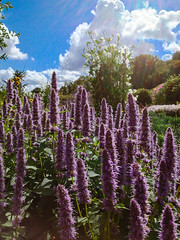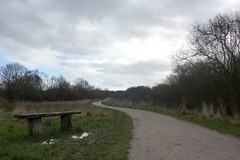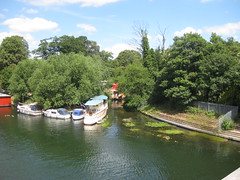Weybridge
Weybridge (English: /ˈwbrɪ/) is a town in the Borough of Elmbridge in Surrey, England, around southwest of central London. The settlement is recorded as Waigebrugge and Weibrugge in the 7th century and the name derives from a crossing point of the River Wey, which flows into the River Thames to the north of the town centre. The earliest evidence of human activity is from the Bronze Age. During the Anglo-Saxon and medieval periods, Weybridge was held by Chertsey Abbey.
In the 1530s, Henry VIII constructed Oatlands Palace to the north of the town centre, which he intended to be the residence of his fourth wife, Anne of Cleves. He married Catherine Howard there in July 1540 and the palace remained a royal residence until the Civil War. The buildings were demolished in the early 1650s and a new mansion, Oatlands House, was constructed to the east of Weybridge later the same century. Prince Frederick, Duke of York and Albany owned the mansion in the 18th century.
The town began to expand beyond its medieval footprint in the early 19th century, catalysed by the initial breakup of the Oatlands House estate, the enclosure of Weybridge Heath and the opening of the railway station in 1838. The developer, W. G. Tarrant, was responsible for the construction of housing on St George's Hill in the first half of the 20th century.
The world's first purpose-built racing circuit was constructed at Brooklands in 1907. The track hosted the first British Grand Prix in 1926 and was used by Malcolm Campbell to develop his final land speed record car, Campbell-Railton Blue Bird. Throughout the 20th century, Brooklands was an important location for the aerospace industry and aircraft developed and tested there included the Sopwith Camel, the Wellington bomber and the Hurricane fighter. Vickers established a factory at the circuit in 1915 and aircraft manufacturing continued at the site until 1988.
Toponymy
The first written records of a settlement at Weybridge date from the 7th century, when its name is given as Waigebrugge and Weibrugge. It appears in Domesday Book of 1086 as Webrige and Webruge and in subsequent surviving documents as Waibrigge and Wabrigge (12th century) and Wybrugge and Weybrugge (13th century). The name simply means "Bridge over the River Wey".
Oatlands is first recorded in 1383 as Otelands, which may indicate that the area was used for the cultivation of oats. The earliest written record of Brooklands is from 1548, when it appears as Brokeland. The name probably means "marshy land". St George's Hill appears to have acquired its current name in the early 17th century. It is recorded as Le Bery in 1337 and Oldebury in 1548. The previous name may derive from the Old English word burh, which might reference the Iron Age earthworks on the hill.
Geography
Location and topography
Weybridge is in northwest Surrey, approximately southwest of central London. The town centre is close to the confluence of the River Wey and the River Thames, but the settlement also includes St George's Hill and Brooklands, to the south. The highest point in Weybridge is above ordnance datum, but the low-lying areas close to the rivers are only above sea level.
Neighbouring settlements include Shepperton to the north, Walton-on-Thames to the east, Wisley to the south and Addlestone to the west.
Geology
The rock strata on which Weybridge sits were deposited in the Cenozoic. The Bagshot Sands are the main outcrop to the south of the town and at Brooklands. From the centre of Weybridge northwards towards the Thames, the surface geology is dominated by river gravels.
Overlying the Bagshot Sands at St George's Hill is a cap of Bracklesham Clay, which was used for brickmaking in the 19th century. Ironstone, containing 33-48% iron(III) oxide, is also found on the Hill, along with a capping of chert gravels, thought to have been deposited by a former course of the River Wey.
History
Early history
The earliest evidence of human occupation in Weybridge is from the Bronze Age. A number of weapons, including socketed axe heads, a rapier, and a palstave, were retrieved from the River Wey close to the Wey Bridge in 1912. At least fifty cinerary urns dating from the same period were found in the area in the 19th and early 20th centuries. Three of the urns were recovered from a barrow during building work on the Silvermere estate (south of St George's Hill) and were found to contain bones and charcoal.
A copper-alloy bucket, now held by the British Museum, was discovered during the construction of the Brooklands racetrack in 1907. It is thought to have originated in northern Italy in the late Bronze or early Iron Age and similar vessels have been found in Austria, Belgium and Germany. During the Iron Age, there was a fort on St George's Hill. It covered an area of around and was protected by a rampart and ditch. Most traces of the fort were destroyed by housebuilding in the first half of the 20th century. Remains of a roundhouse and archaeological evidence of iron workings were discovered in the triangle of land between the railway lines in 1981.
There is not thought to have been a significant Roman presence in Weybridge, but 68 bronze coins of the late 3rd and early 4th centuries were found at Brooklands in 1907. Much of the hoard, which included ''nummi'' from the reigns of Diocletian (284–305 CE), Maximian (286–305), Constantius I (305–306) and Galerius (305–311), was donated to the British Museum.
Governance
There are three separate entries for Weybridge in Domesday Book. The first area of land described was held by Bishop Odo of Bayeux as tenant-in-chief and Herfrid of Throwley as lesser tenant. It included of meadow and woodland for five swine with a value of £5 per annum. The other two entries list areas belonging to Chertsey Abbey, totalling a further 16 acres of meadow, land for four swine and ploughland for 1½ plough teams. None of the entries records a church or a mill in the settlement.
There are only sporadic surviving references to Weybridge in the following centuries. A chapel is mentioned in a papal bull issued by Pope Alexander III in 1176 and a later document shows that Chertsey Abbey had sold the advowson to Newark Priory by 1200. By 1262, the Priory had obtained a license that confirmed its rights to appoint a priest, to hold church property and to collect tithes from the local residents. In 1284 the village was held by Geoffrey de Lucy as a lesser tenant of Chertsey Abbey.
Following the dissolution of the monasteries, Weybridge was held by the Rede family for three years, before passing to the Crown in 1537. In June of the same year, Henry VIII began to construct Oatlands Palace by expanding an existing late-medieval manor house located to the north of the town centre. Some of the stone used in the construction of the foundations was taken from the demolition of Chertsey Abbey. Henry had intended that the palace would become the residence of his fourth wife, Anne of Cleves, but the marriage was annulled after six months. The king married his fifth wife, Catherine Howard, at Oatlands, but rarely visited thereafter. Following Henry's death the palace remained a possession of the Crown until the Commonwealth, when the contents were sold and the buildings demolished. Only a side entrance gate and adjoining sections of walls, which date from , remain.
Reforms during the Tudor period reduced the importance of manorial courts and the day-to-day administration of towns such as Weybridge became the responsibility of the vestry of the parish church. The Weybridge vestry oversaw the distribution of poor relief and the maintenance of local roads. In the 1840s, responsibility for poor relief was transferred to the Chertsey Board of Guardians of the Poor. Local drainage and highways boards were established in the 1860s and in the 1870s a burial board was created to purchase land for new cemeteries.
The Local Government Act 1888 transferred many administrative responsibilities to the newly formed Surrey County Council and was followed by an 1894 Act that created the Weybridge Urban District Council (UDC). Initially the council met at the National school, but moved to Aberdeen House at the junction of High Street and Baker Street in 1908. As a result of the Local Government Act 1929, the UDCs of Weybridge and Walton were combined in 1932. The unified council was merged with the Esher UDC to form Elmbridge Borough Council in 1974.
Residential development
Although Weybridge was still only a small village in the early 18th century, a high proportion of the residents were members of the aristocracy. In 1724, the rector noted that it was increasingly becoming a place for "gentile retirement" and recorded eighteen upper-class families living in the area. The settlement was dominated by two estates: Portmore Park, to the north west of the centre, was the seat of the Colyear family, the Earls of Portmore; Oatlands Park, to the east, had been built on the former deer park belonging to Oatlands Palace and was purchased by Prince Frederick, the Duke of York and Albany, in 1790.
Towards the end of the 18th century, Weybridge was beginning to expand beyond its medieval footprint. In 1800, Weybridge Heath, an area of common land to the south east of the village centre, was enclosed. The Act of Inclosure enabled the Duke of York to purchase almost the whole of St George's Hill and to add it to the Oatlands Estate. Four years later, Hanger Hill, one of the roads running across the heath, was laid out and plots alongside it were sold for housebuilding.
The Duke of York sold Oatlands Park in 1824, but the new owner, Edward Hughes Ball Hughes, was forced to lease the house and the surrounding to Francis Egerton, 1st Earl of Ellesmere, three years later. The remainder of the Oatlands estate was sold in stages between 1828 and 1846. Housebuilding began almost as soon as the land was released, stimulated in part by the opening of Weybridge railway station in 1838. The majority of the houses in…
Looking for places related to Weybridge?
Those are other destinations to find places related to Weybridge:
























